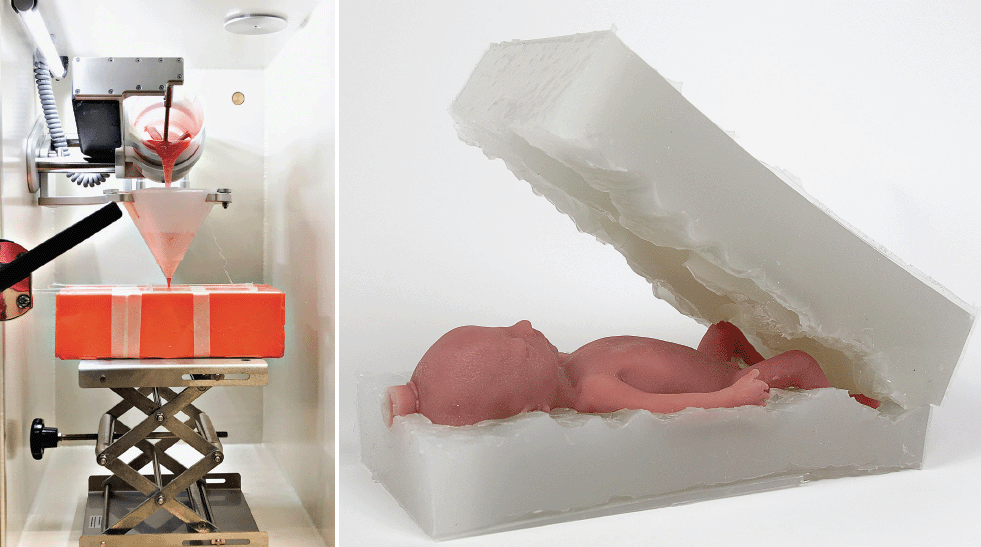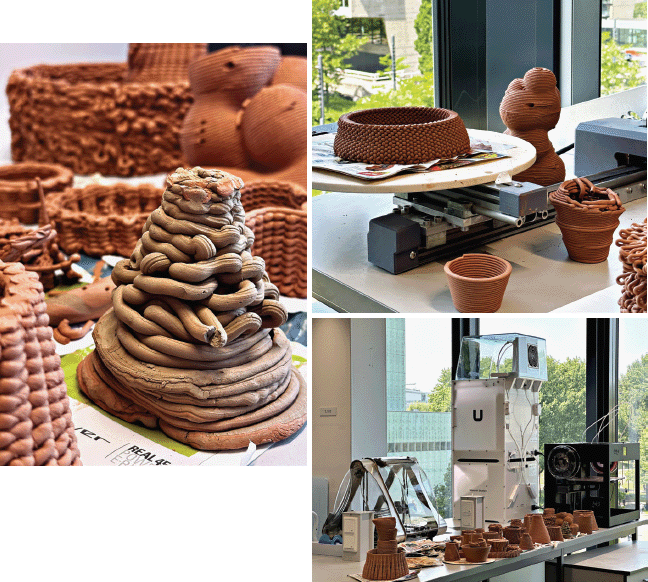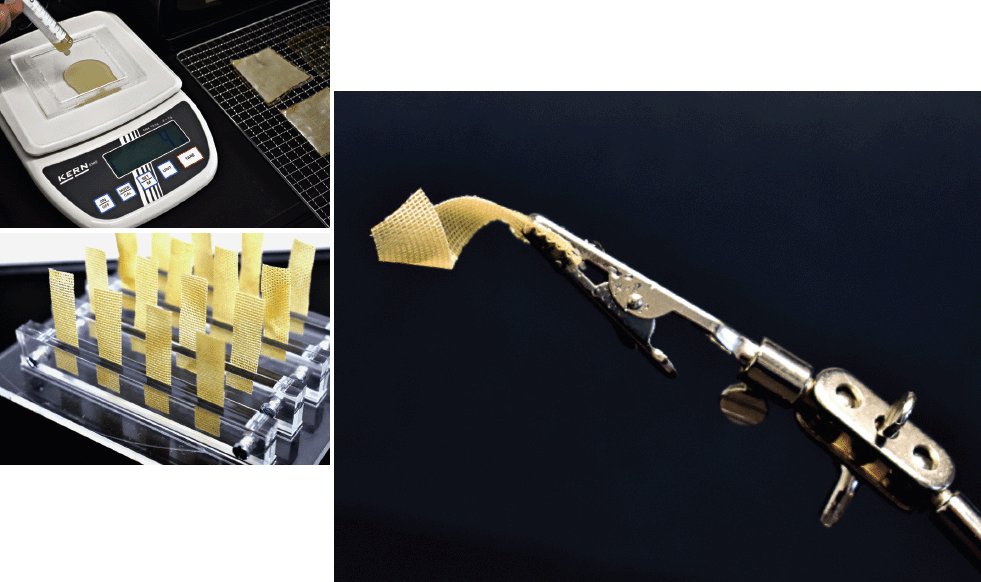The Material Aesthetics Lab: Creating Interactive Experiences with Matter
Issue: XXX.5 September - October 2023Page: 12
Digital Citation
Authors:
Amy Winters, Bahar Barati, Anke van Oosterhout, Miguel Bruns
Imagine a world where the very materials and objects we interact with possess the ability to adapt and transform themselves, akin to being alive. Here, sensing, actuation, computation, and communication become increasingly interwoven into the novel ecologies of materials, artifacts, humans, and nonhumans that we live with, wear, and interact with (Figure 1). The Material Aesthetics Lab (www.materialaesthetics.com), in the Department of Industrial Design at Eindhoven University of Technology, works at the cross section of interaction design, biology, robotics, and materials science.
 | Figure 1. Prototypes addressing human and more-than-human challenges. Clockwise from top left: The Algal Relay Computer (ARC) is a simple form of computer that incorporates the growth of micro-algae in its calculation process [1]; Shape-Changing Food Materials is a collaboration with two-Michelin-starred restaurant Alchemist on incorporating interactive materials into high-end dining [6]; Ripple Thermostat is a designerly exploration into how haptics and shape-change can mediate between humans and intelligent systems [2]. |
We address human and more-than-human challenges by questioning design methods that have disconnected humans from nature [1], and exploring more expressive computational [1,2] and material systems [3]. We aim to redefine interactivity by moving from a focus on efficiency and functionality toward a deeper inclusion of aesthetic and environmentally conscientious approaches. The transformative potential inherent in matter offers an experimental environment for exploring the aesthetics of interaction through soft robotics [3] (Figure 2), shape-changing interfaces [4] (Figure 1), and haptics [2] (Figure 1).
 | Figure 2. Vacuum Fiber Molding Machine. A novel rapid-prototyping approach for thermo-responsive liquid crystal elastomer fiber actuators based on vacuum molding extrusion [3]. |
With a focus on the research themes of more-than-human temporalities, the materiality of care, inclusive gastronomy, sustainable soft robotics, and haptic experience design, we develop and investigate tools and methods through the design and cocreation of experience prototypes. Our researchers prioritize material-driven design methods [5] and frameworks that suggest the behaviors of phenomena in designing interactive matter. Our prototypes aim to engage diverse stakeholders in discussions and reflections about probable and preferable future applications of emerging materials in everyday life.
The Material Aesthetics Lab features a range of digital manufacturing equipment, with a diverse set of materials and fabrication processes, including multi-materials (Figure 3), bio-materials (Figure 4), clay (Figure 5), and 3D food printing (Figure 1). The lab is strategically located across from the electronics and mechanical engineering workshops of the department to facilitate collaboration between different disciplines. The lab has an open studio setup, enabling researchers, graduate students, technicians, as well as artists in residence from diverse backgrounds to support, inspire, and cross-pollinate each other.
 | Figure 3. Artificial Womb. Silicone fetal mannequins for patient simulators as part of the Horizon 2020 Perinatal Life Support Project (Juliette van Haren, Frank Delbressine). |
 | Figure 5. Multispecies Refuge 2050. A clay-printed installation that doubles as an insect refuge and water storage, attending to the needs of future insect generations (Shams Hazim, 2023). |
Projects incorporate a wide range of materials into everyday artifacts; for example, blending the realms of biology, ecology, and economics and their temporalities in projects such as Algal Relay Computer (Figure 1), mycoSonic (Figure 4), and Multispecies Refuge 2050 (Figure 5). They aim to bridge the gaps between people in diverse professions—for example, chefs, experts in creating pleasurable food experiences, and material scientists, developers of more sustainable and healthier edible materials [6]. Through our projects, we devise new tools for designers, such as rapid-prototyping approaches for actuators to improve accessibility and form-giving (Figure 2) [3], thereby illustrating how soft robotics present both a compelling opportunity and novel challenges for the design-HCI community. We also support haptic interaction design through soft- and hardware tools to rapidly sketch and prototype novel tactile and material experiences [2]. We encourage hands-on experimentation to understand how making informs the design process and novel aesthetics; for example, chitosan-based actuators are biodegradable and have multiple functions (Figure 6). Our transdisciplinary approaches to fabrication unlock opportunities for the expressive and performative properties of materials, aiming to inspire researchers from mono-disciplinary STEM fields.
By taking materials, aesthetics, and making as our point of departure, the lab envisions shaping the design engineer of the future. We look forward to collaborating with researchers, artists, and industry and invite you to join the Material Aesthetics Lab launch at the Dutch Design Week, October 21–29, 2023 (https://ddw.nl/) in the Design United (https://www.4tu.nl/du/) and Drivers of Change (https://ddwtue.nl/) exhibitions.
We thank the Departmental Board of Industrial Design, the /d.Search Lab team (Jasper Sterk, Jan Rouvroye, Geert van den Boomen, Chet Bangaru, Wietse Loor, Eden Chiang, Nita Virtala), Stephan Wensveen, Berry Eggen, and all students.
1. Ikeya, Y. and Barati, B. Designing an algal relay computer: A critical orientation in exploring more-than-human temporality. Extended Abstracts of the 2023 CHI Conference on Human Factors in Computing Systems. ACM, New York, 2023; https://doi.org/10.1145/3544549.3585874
2. van Oosterhout, A., Bruns, M., and Hoggan, E. Facilitating flexible force feedback design with Feelix. Proc. of the 2020 International Conference on Multimodal Interaction. ACM, New York, 2020; https://doi.org/10.1145/3382507.3418819
3. Kolvenbag, J., Bruns, M., and Winters, A. Rapid prototyping dynamic robotic fibers for tunable movement. Adjunct Publication of the 35th Annual ACM Symposium on User Interface Software and Technology. ACM, New York, 2022; https://doi.org/10.1145/3526114.3558696
4. Alexander, J. et al. Grand challenges in shape-changing interface research. Proc. of the 2018 CHI Conference on Human Factors in Computing Systems. ACM, New York, 2018; https://doi.org/10.1145/3173574.3173873z
5. Barati, B., Giaccardi, E., and Karana, E. The making of performativity in designing [with] smart material composites. Proc. of the 2018 CHI Conference on Human Factors in Computing Systems. ACM, New York, 2018; https://doi.org/10.1145/3173574.3173579
6. Van Doleweerd, E. and Alonso, M.B. The creation of a holistic interactive dining experience with shape-changing food materials at restaurant Alchemist. Proc. of the 17th International Conference on Tangible, Embedded, and Embodied Interaction. ACM, New York, 2023; https://doi.org/10.1145/3569009.3572791
Amy Winters is an assistant professor at Eindhoven University of Technology. She investigates the transformation of advanced materials into interactive matters. Her interests include cross-disciplinary practices (HCI, materials science, and design) and the temporal qualities of dynamic materials including molecular-driven actuators for soft robotics. She has a Ph.D. in textiles design from the Royal College of Art. [email protected]
Bahar Barati is an assistant professor at Eindhoven University of Technology. Her research revolves around creative processes with emerging (biological) materials and exploring designers' unique contributions to multidisciplinary materials development. Her interests include making with micro-organisms, understanding pluralistic temporal forms, and more-than-human care. She has a Ph.D. in industrial design engineering from TU Delft. [email protected]
Anke van Oosterhout, is an assistant professor at Eindhoven University of Technology. She develops tools to support the design of force feedback and motion in user interfaces. Her interests include the mediating interactions between humans and intelligent systems through haptics and shape-change. She has a Ph.D. in computer science from Aarhus University. [email protected]
Miguel Bruns is an associate professor at Eindhoven University of Technology. He researches the aesthetics and expressivity of interactive systems with programmable material qualities through design. His interests include haptic interaction design, shape-changing interfaces, and 3D-printing edible materials with novel mouthfeels. He has a Ph.D. in industrial design engineering from TU Delft. [email protected]
Copyright held by authors
The Digital Library is published by the Association for Computing Machinery. Copyright © 2023 ACM, Inc.




